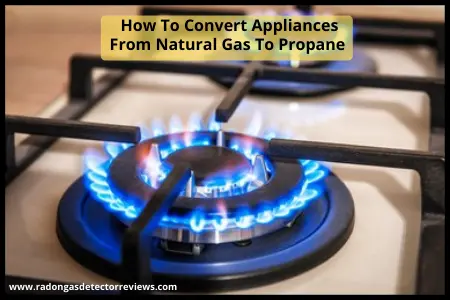Let me tell you that Propane is more efficient than natural gas as it provides more consistent heat.
When appliance consumers realize that each unit of propane contains twice the energy of natural gas and that they can save time by purchasing propane (which is generally stored on-site in a tank) at times when the price is not high, making the switch is advantageous.
Consumers don’t need to replace their appliances however, most – although not all-natural gas appliances can be converted to propane fairly easily. You must keep this in mind.
Conversion kits are available easily and sometimes are included with the appliance. When buying a conversion kit, you should check with the manufacturer to ensure that converting a particular model is safe, and follow the specific instructions for your make and model of appliance.
The major functional difference between propane and natural gas is that propane operates at higher pressure. Hence, the valves and switches need to be changed out so they can properly control the flow of gas.
You should expect to adjust the burner air shutter, too. This shutter controls the ratio of fuel to air and, therefore, is used to adjust the flames. Fine-tune the flames by exchanging natural gas burners for propane burners, which have smaller orifices.
How To Convert Appliances From Natural Gas To Propane

While making the conversion, these are the basic steps you should follow:
- Turn off the gas to the machine (extremely important).
- Disconnect the appliance from the natural gas line.
- Detach the natural gas burners.
- Screw the new burner orifices (designed for propane) onto the burner valves
- Now, connect the appliance to the propane line.
- Properly adjust the burner settings.
It’s a fairly simple and straightforward thing, but there are a few important kinds of stuff you must keep in mind.
For example, while replacing the burner orifices, it may be handy to know the altitude of the unit as well as the brand, model, and serial number of the stove.
It’ll definitely help you because oxygen density varies by altitude, and the elevation of the installation site affects the size of the opening for the burners. For every 1,000 feet, the gas input is reduced by 4 percent.
Also, it is recommended to know the number of top burners, oven burners, and pilot lights needed so you have the necessary parts on hand. Propane orifices sometimes are included in the original purchase and may, therefore, be stored in the back of the range.
When you convert an oven from natural gas to propane, you also need to change the orifice for the pilot light. Unscrew the nut that attaches the pilot tube to the pilot assembly, and remove the tube. The orifice should fall out easily. Just swap it for one designed for propane and reassemble the unit.
The next thing you have to do is replace the existing gas regulator – also called the pressure regulator and it is typically located at the rear of the appliance – with one designed for propane.
Important Note: The arrow on the bottom of the regulator indicates the direction in which the propane will flow. It should point toward the equipment.
Once this is in place, turn on the propane and test all of the connections you have for gas leaks. You can test for leaks by wiping soapy water on the connections and looking for bubbles where any gas leaks out of the system. (Hint: Propane also tends to smell like rotten eggs or skunks)
Light all the pilot lights for the appliance. (You will have to allow a moment for the air to leave the system.)
To adjust flame height, you should turn the adjustment screw on the pilot valve. Do this for each top burner as well as for the oven. Adjust that burner’s air shutter until the tip of each flame is turned blue.
If the appliance has a combination safety valve, it also must be replaced using a conversion kit designed specifically for this valve. Combination safety valves are found most often on furnaces and, in the kitchen, on fryers.
And finally, replace the tag on the equipment that specifies the fuel used so it reflects the conversion.
I hope you may have found this easy guide on How To Convert Appliances From Natural Gas To Propane useful. If you do, please share do share this post with friends who may benefit from it. Thank You.